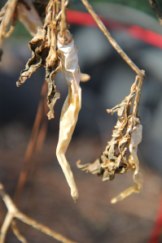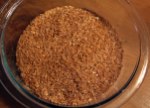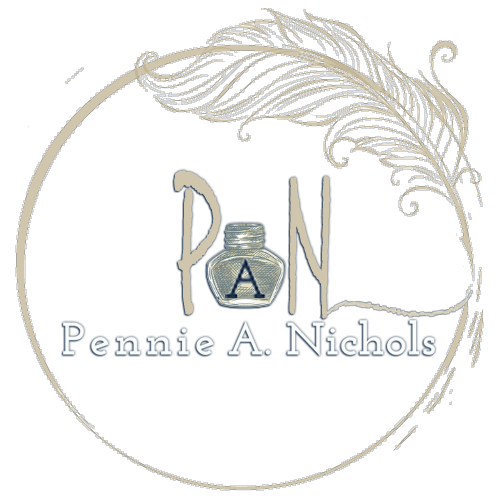Hi. My name is Pennie, and I’m an eke addict.
I eke things for everything they have. I like to squeeze all the life out of the foods and products that come into our home. A few of my peccadillos will sound familiar to some of you, even if you only slightly struggle with this addiction: boiling chicken bones or shrimp shells and heads to make broths, boiling rib bones to enhance the dog food, using compost buckets instead of garbage disposals, keeping a compost pile, and wishing the recycling truck would pass twice a week instead of once (the regular garbage truck could pass just once a month).
Although I’m an amateur addict, I know I am in advancing stages of this addiction because I have some less familiar habits.

My worms receive a handful of food scraps and coffee grounds about once a week in exchange for the castings they make for my garden.
I keep a second compost bucket for eggshells that I eventually grind for the garden. I have a worm colony that thrives in a tub outside my back door.
I use flat cardboard boxes from Costco for starting seedlings.
Additionally (and this habit may border on eccentric for some of you), I ferment citrus scraps —peels and pulp— in reused plastic bottles to make cleaning enzymes.
To feed my addiction, I cull the Internet for ideas. Pages like Food Parts That Are Surprisingly Useful and DIY Life Hacks: 25 easy ways to reuse commonly thrown items make me jump out of my chair and dance around the room. No wonder I can’t stop. The possibilities seem endless.
Back to my addiction. I sometimes —this is starting to get uncomfortable, but I suppose this is why we’re here— I sometimes try to raise the dead. Dead plants, that is.
This was the week of the dead pepper plants.
I finally faced the fallout from the freezes. Dead pepper plants. Hundreds of cayenne, scorpion, and scotch bonnet peppers, now ghosts, snuffed out in their prime. Even the stems closest to the roots snapped dry, lifeless. I knew it was time to let go. As I took a deep breath and began to harvest the dead peppers to add seeds to my already enormous seed collection, a possible eke path revealed itself to me.
The cayenne peppers (did I mention there were hundreds of them?) were dry and crisp, like the red ones I had harvested and dried out months before to make cayenne pepper powder.
I could grind the cayenne pepper ghosts and make a unique pepper powder!
I was dancing in the dead pepper garden.
Ghost Cayenne Pepper powder! No. That would confuse people and ghost pepper fans would be disappointed. White Cayenne Powder? No, boring. This was making me dance. I needed an exciting name to fit the mood. Cayenne Angel Powder? Possibly, although still tame for the moment I was experiencing. Whatever it will be called, the deed is done.

White(ish) Cayenne Powder. Taste notes: not quite as spicy or rich as red cayenne powder, but tasty with a kick. Worth the resurrection.
So that’s my story this week. In a nutshell: I resist letting go. When something goes wrong or when something seems used up, I try one more time, one more thing.
This compulsion is not confined to food, gardening, cardboard boxes, and dead plants, but creeps into my work practices and personal relationships as well. I find ways to reuse and re-purpose the good stuff at work. A rift in a friendship, even a dismal one, is a path to healing and reconciliation, a way to eke more (and better) life out of the connection I have with that friend.
Dead pepper plants become a unique pepper powder. A misunderstanding with a friend becomes a path to deeper communication. I confess I will continue to resist letting go. I will continue to eke out the good in things. I can’t help myself.
Hello. My name is Pennie and I’m an eke addict. I’m not looking for a cure. I’m looking for enablers.
Copyright © 2015 by Pennie Nichols, All Rights Reserved.






I was thinking *eeks* when I saw your title… (lol…), but the concept of *eke* is so much more interesting! Sadly, reading this great post gave me an overwhelming sense of inadequacy… Although I love the idea of sustainability, I’m way more prone to reading about it than actually practicing it. 🙁 Great post!
Keep reading about it! You may find your zone of comfort in it.
Hopefully this spring I can start my own vermicompost. Wish me luck! If you have any suggestions on starting one let me know.
It’s easy to get started and not much work after you set it up. I check on them once a week, feed them a handful of scraps and make sure they’re not too dry or too wet. The hardest part, not really hard but time-consuming, is harvesting the castings. I went to this site for inspiration, my first worms, and information: http://www.worms4earth.com/ They followed through after the arrival of my worms to make sure all was well, and answered additional questions I had after I started my vermicompost.